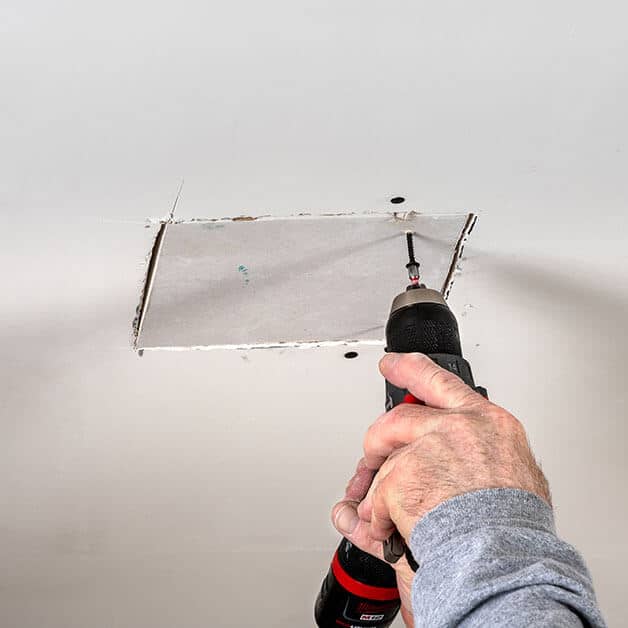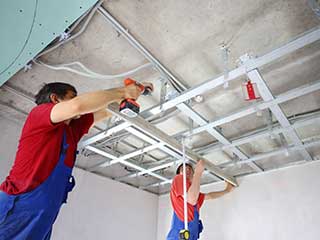Drywall Repair Ogden UT offers reliable services that complement Interior Painting.
Wiki Article
Crucial Tips for Effective Drywall Repair Work and Installment Techniques
Effective drywall repair and installation requires a mindful strategy. Recognizing the kinds of drywall and having the right devices is crucial. Proper techniques and exact dimensions can greatly impact the result. Lots of neglect necessary actions like taping and fining sand, which can make or break the last appearance. As tasks proceed, usual obstacles may occur that require interest. Checking out these ideas can lead to an extra successful and polished finish.Understanding Different Sorts Of Drywall
Recognizing the various types of drywall is necessary for any kind of effective repair work or installment task. Drywall, generally known as plaster board, is available in several selections tailored for certain applications. Criterion drywall is one of the most commonly made use of kind, ideal for basic interior wall surfaces and ceilings. Moisture-resistant drywall, frequently environment-friendly in shade, is created for areas vulnerable to humidity, such as kitchen areas and restrooms. Fireproof drywall, typically tinted pink or purple, is engineered to hold up against higher temperature levels and is frequently utilized in garages or near heating systems. Furthermore, soundproof drywall helps in reducing noise transmission, making it suitable for multi-family homes or taping workshops. Specialty drywall, like concrete board, is utilized in wet locations like showers or bathtub borders. Understanding these types helps in picking the right product for each job, guaranteeing sturdiness and performance out of commission or new installments.Essential Devices for Drywall Fixing and Setup
Having the right tools is necessary for efficient drywall repair service and setup. A quality energy blade is essential for cutting drywall sheets precisely. A drywall T-square aids ensure straight edges, while a taping blade is essential for using joint substance efficiently over joints. Furthermore, a drywall saw enables removing harmed sections or suitable drywall around fixtures.For hanging drywall, a power drill with drywall screws is crucial, as it enables quick and protected installation. A degree is additionally crucial to confirm that the drywall is straight and properly lined up. A sanding block or post sander is vital for smoothing out joint substance once it has actually dried out. A determining tape is important for accurate dimensions, avoiding waste and making sure a proper fit. Outfitted with these devices, individuals can deal with drywall jobs successfully, leading to professional-looking results.
Step-by-Step Overview to Fixing Holes and Cracks
When resolving holes and cracks in drywall, having the right tools and materials is important for a successful fixing. This overview outlines the needed items and gives a clear, step-by-step procedure to effectively bring back the surface. Comprehending these components will certainly aid assure a smooth surface and durable results.Tools and Products Needed
A fully equipped toolkit is essential for effective drywall repair service and installment. Key tools consist of an utility knife for reducing drywall, a tape step to assure accurate sizing, and a drywall saw for larger openings. A putty blade is vital for using joint substance efficiently, while a fining sand block or pole sander aids achieve a seamless surface. For patching, a roll of fiberglass mesh tape or paper tape is needed to enhance joints. Furthermore, a drill and screws are needed for securing brand-new drywall items. Essential materials are composed of joint substance, guide, and paint to finish the repair service. Having these devices and products on hand ensures a smoother, a lot more effective repair work process, generating professional-looking results.Repair Work Refine Actions
Fixing openings and splits in drywall needs a systematic strategy to ensure a seamless surface. Initially, the location bordering the damage should be cleaned thoroughly to remove dust and particles. Next off, for small fractures, a putty blade is utilized to apply a joint substance equally over the area. For larger openings, a patch is needed; the harmed area is reduced out, and a brand-new item of drywall is fitted in location, safeguarded with screws. Once the spot remains in placement, joint compound is applied to mix the sides. After drying, fining sand the location smooth is essential. The fixed surface ought to be primed and painted to match the bordering wall, making certain an inconspicuous repair work.Techniques for Installing Drywall Panels
Setting up drywall panels needs careful preparation and specific implementation to guarantee a specialist and smooth surface. It is crucial to gauge the wall surface room properly and reduce the panels to fit, ensuring that they line up with the studs. Positioning the panels flat is normally advised, as this can enhance the architectural integrity and lower the number of joints.Making use of drywall screws, installers need to secure next page the panels every 16 inches along the studs, making certain a company hold. It is essential to avoid overdriving the screws, which can harm the paper surface. For edges and corners, utilizing an energy blade enables for clean cuts and a snug fit.

Ending Up Touches: Insulation, Mudding, and Sanding
As soon as the drywall panels are securely in position, the next crucial step entails the finishing touches of taping, mudding, and sanding. Taping is essential for developing a smooth change between panels and concealing joints. A high quality drywall tape, either paper or fiberglass mesh, ought to be applied over the seams, ensuring it adheres correctly to the mud that will certainly be applied following.Mudding, or using joint compound, adheres to the taping procedure. This substance fills spaces and smooths out the surface area. A first coat should be applied generously, feathering the edges to mix with the drywall. After the initial layer dries out, subsequent layers might be needed for a flawless coating.
Fining sand is needed to attain a smooth surface. A fine-grit sandpaper ought to be used to carefully smooth out any type of imperfections. Treatment ought to be taken to prevent over-sanding, which can damage the drywall - Drywall Installation Ogden Utah. Effectively implemented, these completing touches develop a specialist appearance prepared for paint
Tips for Keeping Your Drywall After Installation
Keeping drywall after installation is important to preserving its look and architectural integrity. Regular cleaning is needed; dirt and click for info dust can gather, so mild wiping with a wet towel is recommended. House owners ought to likewise check for any kind of indicators of moisture or mold, particularly in high-humidity locations like cooking areas and shower rooms. If any kind of damage takes place, it is necessary to resolve it immediately to avoid additional issues.Making use of furnishings pads can help avoid scrapes or dents from hefty items. Additionally, painting the drywall with a top notch, washable paint provides an added layer of protection and makes future cleaning simpler. Stay clear of using abrasive cleansers or tools, as these can harm the surface. Preserving a secure interior environment with ideal moisture levels will help protect against splitting or deforming over time. By following these tips, one can assure that drywall continues to be in outstanding condition for several years to come.
Often Asked Questions
For How Long Does Drywall Require To Totally Dry After Installment?

Can I Install Drywall Over Existing Drywall?
Yes, drywall can be mounted over existing drywall, however it is necessary to ensure the underlying surface area is safe and secure and appropriately prepared. This method can boost insulation and minimize setup time, though it might add weight.What Is the most effective Way to Soundproof Drywall?
The finest means to soundproof drywall entails utilizing specialized soundproofing products, such as durable channels, acoustic caulk, and sound-dampening drywall. These strategies properly reduce audio transmission between spaces, boosting general acoustic efficiency in living spaces.Exactly how Do I Choose the Right Drywall Thickness?
To choose the best drywall density, take into consideration the application and location. Standard household wall surfaces generally utilize 1/2 inch, while ceilings or specialized areas might need 5/8 inch for added toughness and soundproofing abilities.Are There Eco-Friendly Drywall Options Available?
Yes, green drywall choices are offered. These consist of products made from recycled materials, gypsum boards with reduced unstable organic read the article compounds (VOCs), and those using lasting production processes, using environmentally-conscious selections for building and construction and remodelling projects.Having the right tools is important for efficient drywall repair work and installation. For hanging drywall, a power drill with drywall screws is essential, as it makes it possible for safe and secure and quick installation. Key devices include an utility knife for reducing drywall, a tape measure to guarantee exact sizing, and a drywall saw for larger holes. Yes, drywall can be mounted over existing drywall, yet it is essential to ensure the underlying surface area is safe and appropriately prepared. The ideal method to soundproof drywall involves making use of specialized soundproofing materials, such as durable channels, acoustic caulk, and sound-dampening drywall.
Report this wiki page